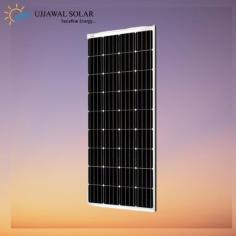
Solar panel:
The solar panel is a device that is used to absorb sunlight.
those absorbed rays are converted into electricity.
thus we can say that solar panels are the device which absorbs sunlight and then sunlight is converted into electricity/heat.
How to convert sunlight into electricity/heat?
Sunlight is used by the photovoltaic modules and to generate electricity from the photovoltaic effect.
A solar panel generates direct current, To be able to use this current in the home or place the surplus on the grid, it has to be converted to an alternating current of 230 V. This is done by the converter, which is integrated into the electrical circuit close to the solar panels.
Solar panel
What material is used for solar cells?
The material which is commonly used for solar cells is Silicon.
Silicon is of three types:
monocrystalline silicon
polycrystalline (or multi-crystalline) silicon
amorphous silicon
Working of solar panels:
Solar panels absorb sunlight and this sunlight is absorbed by the photovoltaic cells during the photovoltaic effect, then generate DC (direct current) . When photons hit a solar cell, they knock electrons loose from their atoms. If conductors are attached to the positive and negative sides of a cell, it forms an electrical circuit. When electrons flow through such a circuit, they generate electricity. Multiple cells make up a solar panel, and multiple panels (modules) can be wired together to form a solar array. The more panels you can deploy, the more energy you can expect to generate.
Advantages of solar panels:
1. The biggest advantage of solar panels is that they reduce electricity bills.
2. Solar panels have low maintenance costs.
3.Installation process is very easy and simple.
4. No cause any harm to our environment. Also does not produce any greenhouse gases.
5.Solar is a renewable and clean source of energy that can help to reduce carbon dioxide emissions.
6. And the main advantage is that it needs only sunlight to generate electricity.
What is the best place to install solar panels for a home?
The best place to install solar panels for a home is the roof, this is because solar panels need maximum sunlight to generate electricity and the roof is the place where the maximum amount of sunlight falls. We should place panels where no blockage occurs and sunlight directly falls on solar panels.
When do solar panel works most?
Solar panels work most on peak time when maximum sunlight falls. Because they need maximum sunlight to generate electricity.
Conclusion:
In this article, we provided you the full information about solar panels. In this article, we discussed that what is solar panels, how they work, what the advantage of solar is, what the best place to install solar panels is, and when they work most.
Ujjawal Solar is a Solar Energy Company led and initiated by the students of YMCA. We are India’s largest Mono PERC Solar modules manufacturer at PAN India Level. We provide you best solar panels for your home.

